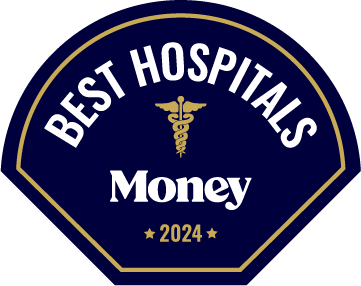Money’s ranking of the best hospitals for cancer care meticulously culls the nation’s cancer-treatment facilities down to a list of the top 75 institutions.
Our methodological approach favors facilities that provide cutting-edge cancer care and research and are staffed by the most experienced oncologists and cancer specialists.
Our data partners for this ranking were Denniston Data and Definitive Healthcare. We also relied on publicly available data from the federal National Cancer Institute, the American College of Surgeons, the Foundation for the Accreditation of Cellular Therapy and the National Comprehensive Cancer Network.
Here’s a detailed look at how we determined our 75 choices.
Setting a strict benchmark
To whittle down the list of the 6,000 or so hospitals across the nation, we created an initial benchmark for facilities to be considered as among the best cancer facilities: Candidate hospitals needed to employ highly experienced oncologists across several different cancer specialties.
Several studies show that the more experienced a physician is with a certain procedure, the better the health outcome for the patient. Our data partner Denniston scores more than 1 million providers through its “Provider Ranking System” (PRS). The PRS measures each provider’s experience with a certain procedure or within a specific specialty by analyzing the frequency of treatment and billable costs as reported to the federal government through the Healthcare Common Procedure Coding System (HCPCS).
The frequency of the procedure by the provider is then compared to other providers. Each practitioner received a score of between 0% to 100% based on their experience — where 98%, for example, means that only 2% of providers ranked higher.
This percentile score ultimately gets translated into a letter grade. Here’s how the grades align with the percentage scores:
- A+ is a CRS score of 95% to 100%.
- A is 85% to 94.99%.
- A- is 80% to 84.99%.
- B+ is 75% to 79.99%.
- B is 65% to 74.99%.
- B- is CRS 60% to 64.99%.
- C+ is 55% to 59.99%.
- C is 45% to 54.99%.
- C- is 40% to 49.99%.
- D+ is 35% to 39.99%.
- D is 25% to 34.99%.
- D- is 20% to 24.99%.
- F is below 20%.
For a hospital to be identified and included in Money’s analysis, it must have at least one A-rated oncologist, as determined by Denniston’s ranking system, in each of the following specialties: medical oncology, radiation oncology, hematology-oncology, surgical oncology and gynecological oncology.
This analysis yielded a total of 19,209 top-rated cancer doctors who are affiliated with 173 hospitals.
Rewarding stand-out cancer care
Next, the facilities that met the benchmark were given a hospital-level score based on a weighted average of its practitioners’ score, known as Denniston’s Compositing Ranking Score (CRS). The CRS follows the same grading system for the facility as is mentioned above for doctors.
A hospital’s CRS was one of three core ranking factors. In this case, Money weighted the factor at 30% of the overall ranking.
We then analyzed several other cancer-related metrics for each of the facilities still in the running. Naturally, the provision of such standard cancer services as chemotherapy and radiation was considered, but the facility received extra credit if it also provided more advanced care, including the likes of intensity-modulated radiation therapy (IMRT) and cellular or cord-blood therapies. We gave preference, too, to hospitals that also offer palliative and hospice services, since it allows patients to receive end-of-life care as needed without having to switch facilities.
Money also gave credit to hospitals that have received accreditations or awards for cancer-related care and research from the National Cancer Institute, the National Comprehensive Cancer Network, the American College of Surgeons and/or the Foundation for the Accreditation of Cellular Therapies.
Recognition from the federal National Cancer Institute is paramount among those accolades. Giving awards to just 72 institutions, the NCI highlights facilities that both conduct state-of-the-art cancer research and provide cutting-edge cancer treatment. NCI-designated facilities often put their groundbreaking research into practice by running clinical trials that allow patients access to novel and emerging cancer treatments.
In our ranking, we cite the designation, if any, the hospital received from the NCI. The highest accolade is as a Comprehensive Cancer Center that demonstrates significant research activities in each of three major areas: laboratory-based research, population-based research and clinical research. A Cancer Center is focused in only one or two of the areas listed above.
These oncological-specialty measures and accolades were collectively weighted at 55% of our overall ranking.
Lastly, our final ranking category considered the hospital’s federal scores, as awarded by the Centers for Medicare & Medicaid Services (CMS).
CMS’s quality rating is based on five key factors that we weighted as follows:
- Mortality (22%): reflects a hospital’s death rates related to various conditions such as cardiovascular issues, strokes, pneumonia and treatable complications after surgery
- Safety (22%): tracks the rate of infections associated with certain surgeries, IVs and catheters and rates of complications after specific procedures
- Readmission (22%): considers how often some patients are readmitted to the hospital, along with how long they stayed and whether there were unplanned visits for outpatient treatment
- Patient experience (22%): gauges whether patients had a positive experience based on their self-reported ratings of how well their doctors and nurses communicated with them; other factors include whether their bathroom was clean and their room was quiet at night
- Timely and effective care (12%): estimates how quickly patients received care for chest pain or strokes; how long they stayed during an ER visit; percent of health care staff who are vaccinated for flu and COVID-19 and other time-sensitive metrics
In a departure from our other Best Hospital rankings, we removed the requirement that a hospital needed a 4- or 5-star quality rating from CMS, for two key reasons. First, due to the nature of treating a population of cancer patients, a hospital specializing in oncology may develop higher-than-average mortality or readmission rates. Secondly, 11 of the nation's most prestigious cancer centers are exempt from CMS data reporting.
We still considered a hospital's CMS ratings — in particular, its patient-experience scores — but did not use them as a hard filter. For scoring purposes, the cancer facilities that do not have CMS quality scores were given the average star rating of the hospitals on our short list, rounded to the nearest star. On our ranking, we denote “exempt” where applicable.
Overall, CMS scores comprised 15% of a hospital's ranking grade. Yet, given our focus on care for cancer patients, we wanted to ensure we did not effectively penalize a hospital’s mortality or readmission rates. Thus, we more heavily weighted the facility’s Patient Experience scores, which the CMS separately compiles in a similar 5-star format.
For cancer care especially, we believe patients’ experience with their doctors — and how well those doctors communicate treatment options, next steps and medication instructions — is of utmost importance. For that reason, the hospitals’ Patient Experience score was weighted at 10.5% of the overall ranking (with the quality scores rounding out the remaining 4.5% of the CMS category).
Measuring price transparency
As an additional criterion to help you choose the best hospital for your situation, Money included its novel Price Transparency grade for each hospital we ranked.
This financial metric is unweighted and does not contribute to a hospital's overall grade or position on our rankings.
Still, we display the score because we consider the ability to accurately know in advance what a procedure or visit will cost you to be vital to avoiding surprises and accurately planning the cost of a hospital stay.
Here’s how we calculated the score: Using data and feedback from Denniston and the nonprofit RAND Health Care, Money analyzed the extent to which a hospital’s publicly listed prices (known as chargemaster prices) accurately align with the revenue the hospital receives from patients or Medicare.
In effect, we wanted to know: Is the listed price similar to the amount that you’re billed after you’re discharged?
We used two ratios to measure this. The first compares the hospital's chargemaster prices and its gross patient revenue, whether paid by uninsured patients or insurance companies; the second ratio is between the gross billed amount and the total amount approved by Medicare. Weighted equally, these ratios were standardized on a 100-point scale and translated into a letter grade based on the same ranges as listed above for the CRS.
In almost all cases, patients pay less — and often far less — than the publicly listed prices.
While this practice is technically discounting, the reality is that many hospitals publicly list exorbitant chargemaster prices that then get negotiated down by insurers, the federal government or the patients themselves behind closed doors, thus obfuscating what hospital care truly costs and keeping prices high overall.
Keep in mind that the price transparency grade does not necessarily mean that a hospital with a B+ grade is cheaper than one graded as a C. Rather, it means the higher-graded hospital provides publicly listed prices that are more accurate, which can better help you financially prepare for your stay.
Vetting the top-scoring hospitals
Data and numbers don’t always tell the full story. So Money also individually vetted our list of top-rated hospitals for any red flags that may not have shown up in the numbers we crunched.
As a result, we purged from the list several hospitals at which patient care had been compromised in a manner that suggested underlying issues in the facility. These trouble signs include falsified research or hospital data as well as valid complaints of sexual harassment, malpractice, unnecessary care or similar issues that compromise patient care.
The result is 75 top-notch hospitals that provide cutting-edge cancer care, handpicked by Money’s editorial staff.
Data sources: Denniston Data; Definitive Healthcare
Supplementary data: Agency for Healthcare Research and Quality; American College of Surgeons; Centers for Medicare & Medicaid Services; Foundation for the Accreditation of Cellular Therapy (FACT); National Cancer Institute; National Comprehensive Cancer Network; RAND Health Care






